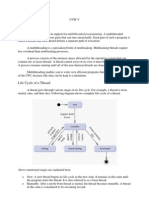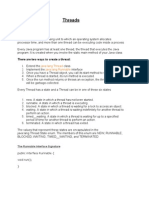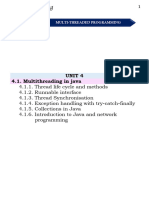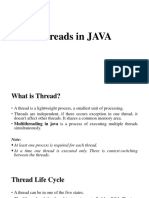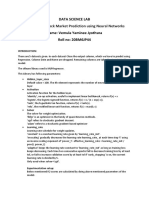The Java Thread Model
Uploaded by
SuryaThe Java Thread Model
Uploaded by
SuryaSEM-III
KNS INSTITUTE OF TECHNLOGY
JAVA CH-4
DEPARTMENT OF MCA
4.2 THE JAVA THREAD MODEL
The Java run-time system depends on threads for many things, and all the class libraries are
designed with multithreading in mind.
In fact, Java uses threads to enable the entire environment to be asynchronous.
This helps reduce inefficiency by preventing the waste of CPU cycles.
Threads exist in several states.
A thread can be running. It can be ready to run as soon as it gets CPU time.
A running thread can be suspended, which temporarily suspends its activity.
A suspended thread can then be resumed, allowing it to pick up where it left off.
A thread can be blocked when waiting for a resource.
At any time, a thread can be terminated, which halts its execution immediately.
Once terminated, a thread cannot be resumed.
The Thread Class and the Runnable Interface:
To create a new thread, your program will either extend Thread or implement the Runnable
interface.
The Thread class defines several methods that help manage threads few among them are:
Method
getName
getPriority
isAlive
Join
Run
Sleep
Start
Meaning
Obtain a thread's name.
Obtain a thread's priority.
Determine if a thread is still running.
Wait for a thread to terminate.
Entry point for the thread.
Suspend a thread for a period of time.
Start a thread by calling its run method.
4.3 THE MAIN THREAD
When a Java program starts up, one thread begins running immediately that is main.
The main thread is important for two reasons:
o This is the main thread from where other threads will be called
o Often, it must be the last thread to finish execution because it performs various
shutdown actions.
Lecturer: Syed Khutubuddin Ahmed
E-Mail: khutub27@gmail.com
SEM-III
KNS INSTITUTE OF TECHNLOGY
JAVA CH-4
DEPARTMENT OF MCA
Note:
Although the main thread is created automatically when your program is started, it can be
controlled through a Thread object.
To do so, you must obtain a reference to it by calling the method currentThread( ), which is a
public static member of Thread.
Its general form is shown here:
static Thread currentThread( )
This method returns a reference to the thread in which it is called. Once you have a reference
to the main thread, you can control it just like any other thread.
Example program of Main Thread:
class CurrentThreadDemo
{
public static void main(String args[]) {
Thread t = Thread.currentThread();
System.out.println("Current thread: " + t);
// change the name of the thread
t.setName("My Thread");
System.out.println("After name change: " + t);
try {
for(int n = 5; n > 0; n--) {
System.out.println(n);
Thread.sleep(1000);
}
} catch (InterruptedException e) {
System.out.println("Main thread interrupted");
}
}
}
Output of Program:
Current thread: Thread[main,5,main]
After name change: Thread[My Thread,5,main]
5
4
3
2
1
Notice the output produced when t is used as
an argument to println( ).
This displays, in order: the name of the
thread, its priority, and the name of its group.
By default, the name of the main thread is
main.
Its priority is 5, which is the default value,
and main is also the name of the group of
threads to which this thread belongs.
The sleep( ) method causes the thread from which it is called to suspend execution for the
specified period of milliseconds. Its general form is shown here:
static void sleep(long milliseconds) throws InterruptedException
The number of milliseconds to suspend is specified in milliseconds. This method may throw
an InterruptedException.
Lecturer: Syed Khutubuddin Ahmed
E-Mail: khutub27@gmail.com
SEM-III
KNS INSTITUTE OF TECHNLOGY
JAVA CH-4
DEPARTMENT OF MCA
The sleep( ) method has a second form, shown next, which allows you to specify the period in
terms of milliseconds and nanoseconds:
static void sleep(long milliseconds, int nanoseconds) throws InterruptedException
This second form is useful only in environments that allow timing periods as short as
nanoseconds.
You can obtain the name of a thread by calling getName( ).
These methods are members of the Thread class and are declared like this:
final void setName(String threadName)
final String getName( )
4.4 CREATING A THREAD
In the most general sense, you create a thread by instantiating an object of type Thread.
You can implement the Runnable interface.
You can extend the Thread class, itself.
4.4.1 Implementing Runnable
The easiest way to create a thread is to create a class that implements the Runnable interface.
To implement Runnable, a class need only implement a single method called run( ), which is
declared like this:
public void run( )
Inside run( ), you will define the code that constitutes the new thread.
It is important to understand that run( ) can call other methods, use other classes, and declare
variables, just like the main thread can.
The only difference is that run( ) establishes the entry point for another, concurrent thread of
execution within your program.
This thread will end when run( ) returns.
After you create a class that implements Runnable, you will instantiate an object of type
Thread from within that class.
Thread defines several constructors.
The one that we will use is shown here:
Thread(Runnable threadOb, String threadName)
Lecturer: Syed Khutubuddin Ahmed
E-Mail: khutub27@gmail.com
SEM-III
KNS INSTITUTE OF TECHNLOGY
JAVA CH-4
DEPARTMENT OF MCA
Example program showing Creation of Thread using Runnable Interface:
class NewThread implements Runnable {
Thread t;
NewThread()
{
t = new Thread(this, "Demo Thread");
System.out.println("Child thread: " + t);
t.start(); // Start the thread
}
public void run() {
try {
for(int i = 5; i > 0; i--) {
System.out.println("Child Thread: " + i);
Thread.sleep(500);
}
} catch (InterruptedException e) {
System.out.println("Child interrupted.");
}
System.out.println("Exiting child thread.");
}
}
Lecturer: Syed Khutubuddin Ahmed
class ThreadDemo {
public static void main(String args[]) {
new NewThread(); // create a new thread
try {
for(int i = 5; i > 0; i--) {
System.out.println("Main Thread: " + i);
Thread.sleep(1000);
}
}
catch (InterruptedException e) {
System.out.println("Main thread interrupted.");
}
System.out.println("Main thread exiting.");
}
}
Output:
Child thread: Thread[Demo Thread,5,main]
Main Thread: 5
Child Thread: 5
Child Thread: 4
Main Thread: 4
Child Thread: 3
Child Thread: 2
Main Thread: 3
Child Thread: 1
Exiting child thread.
Main Thread: 2
Main Thread: 1
Main thread exiting.
E-Mail: khutub27@gmail.com
SEM-III
KNS INSTITUTE OF TECHNLOGY
JAVA CH-4
DEPARTMENT OF MCA
4.4.2 Extending Thread
class NewThread extends Thread {
NewThread()
{
super("Demo Thread");
System.out.println("Child thread: " + this);
start(); // Start the thread
}
public void run() {
try {
for(int i = 5; i > 0; i--) {
System.out.println("Child Thread: " + i);
Thread.sleep(500);
}
} catch (InterruptedException e) {
System.out.println("Child interrupted.");
}
System.out.println("Exiting child thread.");
}
}
class ExtendThread {
public static void main(String args[]) {
new NewThread(); // create a new thread
try {
for(int i = 5; i > 0; i--) {
System.out.println("Main Thread: " + i);
Thread.sleep(1000);
}
} catch (InterruptedException e) {
System.out.println("Main thread interrupted.");
}
System.out.println("Main thread exiting.");
}
}
Notice the call to super( ) inside NewThread.
This invokes the following form of the Thread
constructor:
public Thread(String threadName)
Here, threadName specifies the name of the
thread.
4.5 Creating Multiple Threads
class NewThread implements Runnable {
String name; // name of thread
Thread t;
NewThread(String threadname) {
name = threadname;
t = new Thread(this, name);
System.out.println("New thread: " + t);
t.start(); // Start the thread
}
public void run() {
try {
for(int i = 5; i > 0; i--) {
System.out.println(name + ": " + i);
Thread.sleep(1000);
i) A Second Use for super:
}
}
Lecturer: Syed Khutubuddin Ahmed
catch (InterruptedException e) {
System.out.println(name + "Interrupted");
}
System.out.println(name + " exiting.");
}} // end of NewThread class
class MultiThreadDemo {
public static void main(String args[]) {
new NewThread("One");// start threads
new NewThread("Two");
new NewThread("Three");
try {
Thread.sleep(10000);
} catch (InterruptedException e) {
System.out.println("Main thread Interrupted");
}
System.out.println("Main thread exiting.");
}}
E-Mail: khutub27@gmail.com
SEM-III
KNS INSTITUTE OF TECHNLOGY
JAVA CH-4
DEPARTMENT OF MCA
OUTPUT:
New thread: Thread[One,5,main]
New thread: Thread[Two,5,main]
New thread: Thread[Three,5,main]
One: 5
Two: 5
Three: 5
One: 4
Two: 4
Three: 4
One: 3
Three: 3
Two: 3
One: 2
Three: 2
Two: 2
One: 1
Three: 1
Two: 1
One exiting.
Two exiting.
Three exiting.
Main thread exiting.
4.6 Using isAlive( ) and join( )
Note: main method should finish last compare to all the threads.
This is accomplished by calling sleep( ) within main( ), with a long enough delay to ensure that all
child threads terminate prior to the main thread.
It also raises a larger question:
How can one thread know when another thread has ended?
Two ways exist to determine whether a thread has finished execution:
1) isAlive()
2) join()
isAlive() :
Call isAlive( ) on the thread.
This method is defined by Thread, and its general form is shown here:
final boolean isAlive( )
The isAlive( ) method returns true if the thread called is still running
Lecturer: Syed Khutubuddin Ahmed
E-Mail: khutub27@gmail.com
You might also like
- Multithreading:-: Smallest Unit of ProcessingNo ratings yetMultithreading:-: Smallest Unit of Processing3 pages
- Java - Multithreading: Life Cycle of A ThreadNo ratings yetJava - Multithreading: Life Cycle of A Thread7 pages
- Module 5 Topic Wize Oops With Java 24-25No ratings yetModule 5 Topic Wize Oops With Java 24-2559 pages
- Module 5 Topic Wize Oops With Java 24-25 (2)No ratings yetModule 5 Topic Wize Oops With Java 24-25 (2)50 pages
- Lect01: Multithreaded Programming: Writing Concurrently Running ThreadsNo ratings yetLect01: Multithreaded Programming: Writing Concurrently Running Threads20 pages
- Java Programming: Multi Threading, I/O Streams Topics Covered in This UnitNo ratings yetJava Programming: Multi Threading, I/O Streams Topics Covered in This Unit32 pages
- 0b6at Wuxbp6ldWN1RWt6ZS1oWnZvbk5qTFYwdHVSSGxWYkV3No ratings yet0b6at Wuxbp6ldWN1RWt6ZS1oWnZvbk5qTFYwdHVSSGxWYkV340 pages
- Threads, Processes and Multitasking: Java® TutorialNo ratings yetThreads, Processes and Multitasking: Java® Tutorial5 pages
- Unit IV Multithreadingappletsnetworking - RemovedNo ratings yetUnit IV Multithreadingappletsnetworking - Removed14 pages
- Unit - Iv 4.1 Multithreading ProgrammingNo ratings yetUnit - Iv 4.1 Multithreading Programming22 pages
- Concurrent Programming in Java: Mrs. S.S.Jamsandekar Department of Computer Science Shivaji UniversityNo ratings yetConcurrent Programming in Java: Mrs. S.S.Jamsandekar Department of Computer Science Shivaji University27 pages
- IGNOU PGDCA MCS 206 Object Oriented Programming using Java Previous Years solved PapersFrom EverandIGNOU PGDCA MCS 206 Object Oriented Programming using Java Previous Years solved PapersNo ratings yet
- 4.2.1 File: Sem-Iii Kns Institute of Technlogy Java Ch-4 Department of McaNo ratings yet4.2.1 File: Sem-Iii Kns Institute of Technlogy Java Ch-4 Department of Mca3 pages
- 4.11 Using Multithreading: Performance of Your Program Rather Than Enhance ItNo ratings yet4.11 Using Multithreading: Performance of Your Program Rather Than Enhance It1 page
- Inheritance, Package, Interface and Exception Handling 3.1 InheritanceNo ratings yetInheritance, Package, Interface and Exception Handling 3.1 Inheritance7 pages
- (11-16) 3B-Ch.7-Areas - Volumes (III) - ANSNo ratings yet(11-16) 3B-Ch.7-Areas - Volumes (III) - ANS13 pages
- Sulfur Iodine Process Summary For The Hydrogen Technology Down-SelectionNo ratings yetSulfur Iodine Process Summary For The Hydrogen Technology Down-Selection49 pages
- ECON 357: Lecture 8: The Growth and Variance of RM SizesNo ratings yetECON 357: Lecture 8: The Growth and Variance of RM Sizes17 pages
- Dynamic Surface Tension - KRÜSS ScientificNo ratings yetDynamic Surface Tension - KRÜSS Scientific4 pages
- Data Science Lab Assignment: Name: Vemula Yaminee Jyothsna Roll No: 20BM6JP44No ratings yetData Science Lab Assignment: Name: Vemula Yaminee Jyothsna Roll No: 20BM6JP442 pages
- Karl Popper s Science and Philosophy Zuzana Parusniková - Get instant access to the full ebook content100% (1)Karl Popper s Science and Philosophy Zuzana Parusniková - Get instant access to the full ebook content73 pages
- QSFP28-100G-LR4 100Gb/s QSFP28 LR4 Transceiver: Product FeaturesNo ratings yetQSFP28-100G-LR4 100Gb/s QSFP28 LR4 Transceiver: Product Features8 pages
- Electronic Effects On Ketoe Enol Tautomerism of P-SubstitutedNo ratings yetElectronic Effects On Ketoe Enol Tautomerism of P-Substituted8 pages
- Entity Relationship Diagram: InformationNo ratings yetEntity Relationship Diagram: Information21 pages












